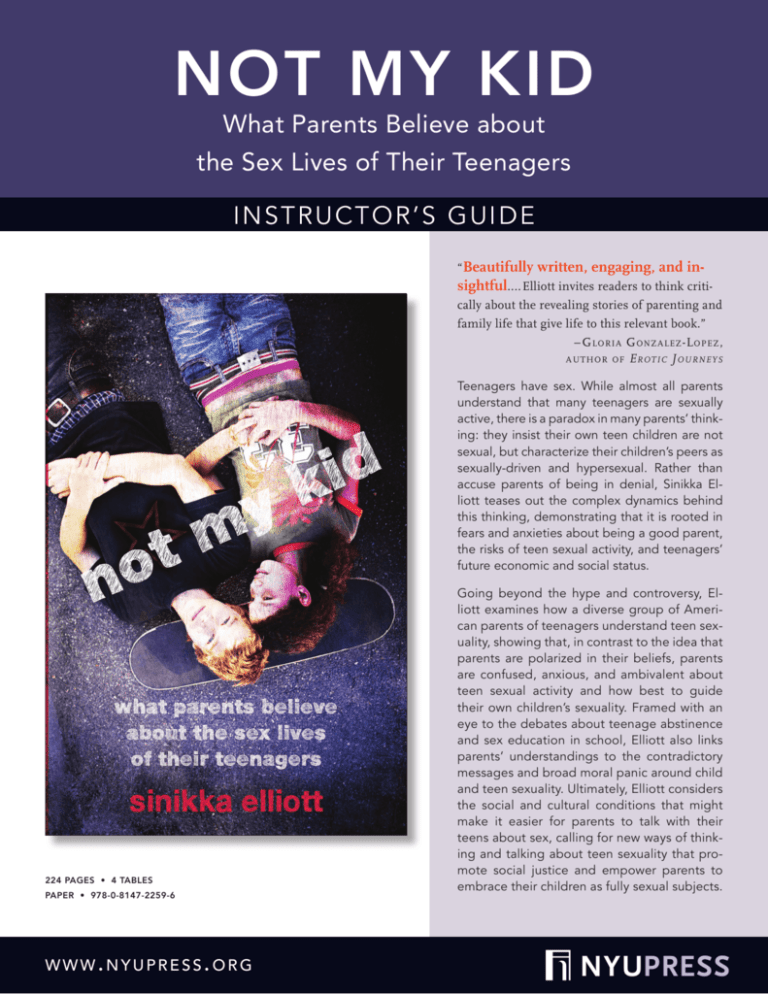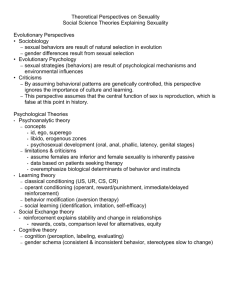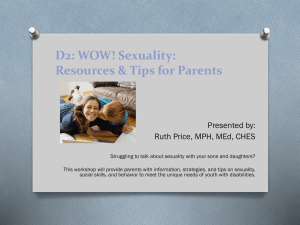
NOT MY KID
What Parents Believe about
the Sex Lives of Their Teenagers
INSTRUCTOR’S GUIDE
“ Beautifully written, engaging, and insightful.... Elliott invites readers to think critically about the revealing stories of parenting and
family life that give life to this relevant book.”
– G LORIA G ONZALEZ -L OPEZ ,
AUTHOR OF E ROTIC J OURNEYS
Teenagers have sex. While almost all parents
understand that many teenagers are sexually
active, there is a paradox in many parents’ thinking: they insist their own teen children are not
sexual, but characterize their children’s peers as
sexually-driven and hypersexual. Rather than
accuse parents of being in denial, Sinikka Elliott teases out the complex dynamics behind
this thinking, demonstrating that it is rooted in
fears and anxieties about being a good parent,
the risks of teen sexual activity, and teenagers’
future economic and social status.
224 PAGES • 4 TABLES
PAPER • 978-0-8147-2259-6
WWW.NYUPRESS.ORG
Going beyond the hype and controversy, Elliott examines how a diverse group of American parents of teenagers understand teen sexuality, showing that, in contrast to the idea that
parents are polarized in their beliefs, parents
are confused, anxious, and ambivalent about
teen sexual activity and how best to guide
their own children’s sexuality. Framed with an
eye to the debates about teenage abstinence
and sex education in school, Elliott also links
parents’ understandings to the contradictory
messages and broad moral panic around child
and teen sexuality. Ultimately, Elliott considers
the social and cultural conditions that might
make it easier for parents to talk with their
teens about sex, calling for new ways of thinking and talking about teen sexuality that promote social justice and empower parents to
embrace their children as fully sexual subjects.
NYUPRESS
INTROD UCTI ON
Pages 1-7
SUMMARY
Opening with a mother’s description of her fears for her 14-year-old son’s sexual safety, the introduction develops the book’s main finding: the parents interviewed said their own children are not sexual but viewed other teenagers—their
children’s peers—as highly sexually motivated. Parents’ anxieties about their
children’s sexuality offer a window to explore modern ways of thinking about
adolescence, sexuality, and parental accountability, as well as the role of social
inequality in an increasingly unequal society.
DISCUSSION POINTS
The introduction serves as a foundation for the book, introducing the reader to
the study methodology and the book’s main themes, which include:
• parents’ conflict about youth sexuality and how their stories serve as an important
counterpoint to the ideologically-driven debates over teen sexuality
• the complex dynamics that shape how parents talk to their children about sexuality
• the ways parents’ conversations with their teens about sex reflect and reproduce social
inequalities of race, class, gender, and sexuality
2
NYU PRESS INSTRUCTOR’S GUIDE
SUMMARY
Looking at local and national debates over sex education, this chapter provides
the historical background necessary to make sense of America’s complex relationship to sexuality. Introducing readers to a sociological way of thinking about
sexuality, the chapter demonstrates how American sexual practices and the
regulation of sexuality have changed over time and are closely linked to broader social processes, such as America’s urbanization and industrialization, and to
social inequalities based on gender, race, and social class.
CH AP TER 1
Sex Panics, pages 9-19
DISCUSSION QUESTIONS
➥➥ What was the Adolescent Family Life Act and what is its significance?
➥➥ How does the Personal Responsibility and Work Opportunity Reconciliation
Act (also known as welfare reform) define abstinence-only sex education?
➥➥ Define “discourses.” What are the dominant discourses of sexuality in the U.S.
and where do they come from?
➥➥ What does legistators’ historical opposition to changing the age of sexual
consent tell us about pre-nineteenth century understandings of childhood and
child sexuality? How and why have ideas about childhood and child sexuality
shifted in the modern era?
➥➥ In what ways are sexuality and social inequality intertwined in the United States?
NOT MY KID
3
CH AP TER 2
The Asexual Teen, pages 20-46
SUMMARY
Tracing parents’ views of their children in relation to sexuality, this chapter charts
how and why parents describe their children as young, immature, and sexually
naïve. Pointing to larger controversies around child sexuality, such as whether to
make a vaccine for the sexually transmitted infection HPV mandatory for 11-yearold girls, the chapter argues that parents are not alone in wanting to maintain
a notion of children as asexual. Parents are clearly frightened of the risks that
sex poses to their children and want them to be safe from the dangerous consequences of sex. Their uncertainty about how to achieve this reflects larger conflicts about how best to protect young people from sexual risk. Drawing on the
experiences of two parents whom Child Protective Services investigated because
people thought their children were too sexually knowledgeable, the chapter also
shows that parents can face consequences if their children seem to know too
much about sex.
DISCUSSION QUESTIONS
➥➥ What do the parents’ discussions in this chapter reveal about their ideas on
youth sexuality? Why do parents say their children are sexually innocent?
➥➥ Most of the parents in the book talked with their children about contraception
but felt conflicted about these conversations. Why?
➥➥ What is “the danger discourse of teen sexuality”? Is sex more dangerous than
it used to be?
➥➥ What does the controversy over school districts mandating an HPV vaccine
say about the political climate around youth sexuality in the U.S.?
➥➥ Analyze the glossary of sexual and reproductive terms at the end of the
chapter: what is included and what is missing from the glossary?
4
NYU PRESS INSTRUCTOR’S GUIDE
SUMMARY
When parents try to initiate conversations about sex their children sometimes
resist, saying they don’t want to talk about sex with their parents. Exploring the
dynamics of family sex talk, the chapter points to the prominent role gender and
emotions play in these conversations. Mothers described boys as especially resistant to their efforts to talk with them about sex. Even though sex is all around
us in U.S. culture, people who talk openly about sex are said to have no shame:
the emotion of shame and the idea that sex is private can create discomfort for
parents, even those who wish to speak openly about sex with their children.
CH AP TER 3
Negotiating the Erotic, pages 47-62
DISCUSSION QUESTIONS
➥➥ How do family conversations about sex challenge the notion that parental
power is absolute?
➥➥ This chapter argues that gender inequality in society makes it difficult for
parents and teenagers to discuss sexuality. Discuss three ways that gender
stereotypes inhibit open communication about sex. Provide a specific
example of each.
➥➥ What is “shame” and how is it connected to sexuality? What does shame have
to do with family sex talk?
NOT MY KID
5
CH AP TER 4
The Hypersexual Teen, pages 63-82
SUMMARY
Teenagers, with their raging hormones and attractive young bodies, are incapable of handling the responsibilities of sex, said parents, a belief shared by many
Americans. Exploring how parents talk about sex, age, and responsibility, this
chapter points to a binary they construct between responsible adult sexuality
and irresponsible teen sexuality. This binary is linked to historically- and culturally-specific ideas about adolescence, a developmental stage in the life course
discovered in 1904. Scratching below the surface of the adolescent-adult sexual
binary, however, reveals that parents are quite worried about the harm adult sexual predators pose to their children. From advertising portraying youthful bodies
as the cultural epitome of sexiness to popular television programs about pedophiles, media images present young people as not simply innocent and vulnerable, but as profoundly desirable because of their youthful innocence. These dual
associations magnify adults’ fears about child and teen sexual safety.
DISCUSSION QUESTIONS
➥➥ Define “binary thinking” and “controlling images” and provide examples of
how each affect adults’ willingness to trust young people with sexual
knowledge and citizenship.
➥➥ Why do parents think teenagers are incapable of making responsible
decisions around sexuality? Are parents the only ones who think this way?
➥➥ This chapter argues that, when it comes to sexuality, age is an important axis
of social inequality. Explain what this means.
➥➥ How does the discourse that sexual predators can be anyone and everywhere
make it difficult to gauge sexual danger?
➥➥ Why might even American adults find it difficult to achieve happy, safe,
fulfilling sexual relationships?
6
NYU PRESS INSTRUCTOR’S GUIDE
SUMMARY
Parents do not simply view adults as potential threats to their teenagers’ sexual
well-being; they also worry about their children’s peers whom they described as
“openly sexual,” “promiscuous,” and a threat to their children’s sexual innocence
and safety. But not all teenagers pose an equal danger: parents routinely used
race, class, and gender in constructing “other” teens as hypersexual in contrast
to their asexual children. Linking parents’ binary thinking to longstanding sexual
stereotypes of the poor, new immigrants, people of color, and gays and lesbians,
this chapter points to the role sexuality plays in notions of good citizenship in a
highly unequal society like the U.S.
CH AP TER 5
Other Teens, pages 83-98
DISCUSSION QUESTIONS
➥➥ How and why did the parents talk about race and class in veiled and
coded language?
➥➥ Which groups historically bore the mantle of “bad” sexuality and with
what consequences?
➥➥ What is “heteronormativity” and how are parents’ assumptions about their
children heteronormative?
➥➥ What is the good girl/bad girl dichotomy? Does it still have relevance for
teenage girls’ sexual experiences?
➥➥ Why do sexual binaries and hierarchies exist at all? Whose interests do
they serve?
NOT MY KID
7
CH AP TER 6
Anxious Monitoring, pages 99-117
SUMMARY
The danger discourse of teen sexuality informs parents’ sense that their teenagers, facing peer pressure and risk, need to be kept busy and carefully monitored.
Despite parents’ common belief in the need to protect their children, parental
monitoring is shaped and constrained by the resources at parents’ disposal.
Middle-class parents can access a range of enrichment programs to keep their
children busy as well as technology to monitor their whereabouts. Lower-income
parents literally use their bodies to safeguard their teenagers. This chapter delineates these strategies and discusses their consequences for parents’ and teenagers’ well-being.
DISCUSSION QUESTIONS
➥➥ Why do parents want their teenage children to be involved in
extracurricular activities?
➥➥ Why are parents so worried about their children’s friendships? How do they
try to monitor them?
➥➥ How do parents use technology in their efforts to keep their children safe?
Why are some parents conflicted about the Internet?
➥➥ How does Charlene’s story show the different consequences of parents’
vigilance in protecting their children?
8
NYU PRESS INSTRUCTOR’S GUIDE
SUMMARY
Many parents promote sexual abstinence when they talk about sex with their children, even as they doubt its practicality. This chapter explores parents’ ambivalent relationship to abstinence and other advice they give their children about
sex. Using the term ambivalence more in a sociological than psychological sense,
the chapter shows how ambivalence stems from pressures imposed by the contradictory demands placed on parents. Highlighting the stories of two parents—a
liberal mother of two teenage daughters and a conservative father of one teenage son—reveals the role gendered sexual double standards and heteronormativity play in parents’ concerns about how best to guide teen sexuality. Parents’
stories demonstrate that American parents are not so neatly divided into sexual
liberals and conservatives, as the debates over sex education would suggest.
CH AP TER 7
Uncertainty in Parents’ Sexual Lessons, pages 118-143
DISCUSSION QUESTIONS
➥➥ What is “ambivalence”? How do sociologists study ambivalence?
➥➥ Why do parents talk to their children about abstinence even as many think it is
an unrealistic expectation for their teens?
➥➥ Research into the debates over sex education finds that Americans are divided
into sexual liberals and conservatives. Describe the beliefs of these two
groups. Can parents of teenagers be clearly divided into these two groups?
Why or why not?
➥➥ In what ways do Corina and Sharon’s concerns about their teenage daughters’
sexual safety and well-being illustrate gendered sexual double standards?
➥➥ How do Scott’s concerns about his son’s sexuality demonstrate the links
between heterosexuality and masculinity?
NOT MY KID
9
CH AP TER 8
Conclusion, pages 144-155
SUMMARY
The conclusion reviews the practical and theoretical implications of the book. It
discusses the things we can do as a society to better support families and diverse
sexualities. Sexuality is not fixed but is a fluid, changing, and contested site of
social control and resistance. Transforming the ways Americans deal with teen
sexuality would involve challenging the danger discourse of teen sexual activity
and dominant ideas about teenagers as incapable of managing the risks of sex.
It would also involve a strong social justice ethos that confronts racist, sexist, and
heteronormative sexual stereotypes.
APPENDIX, PAGES 157-163
The appendix provides a more detailed account of the study methods and the
demographics of the parents interviewed.
10
NYU PRESS INSTRUCTOR’S GUIDE
QUESTIONS FOR REFLECTION
➥➥ What did you learn about sex at home? At school? Who taught you?
➥➥ How and why have children’s and teens’ sexualities come to be a topic of
urgent public and private concern?
➥➥ How is religion connected to parents’ messages to teens regarding sex
and sexuality?
➥➥ What are the theoretical implications of “Not my kid”? Is sexuality an
important component of social life? Why or why not?
➥➥ What did you think was the most compelling argument about why parents
have such difficulty talking with their children about sexuality?
➥➥ What is the relationship between institutions (schools, government, work,
family) and family sex talk?
SUPPLEMENTAL ASSIGNMENTS
➥➥ In chapter three of Not My Kid, Sinikka Elliott argues that gender inequality in
society makes it difficult for parents and teenagers to discuss sexuality.
Discuss three ways that gender stereotypes inhibit open communication about
sex. Provide a specific example of each.
➥➥ Discuss the two mainstream approaches to sex education:
abstinence-only-until-marriage and comprehensive sex education. What
assumptions do they make about gender and sexuality? Next, explain Elliott’s
pro-sex perspective on sex education, and compare and contrast its
assumptions with those of the two mainstream approaches.
➥➥ According to Elliott, many parents believe their teenagers are not interested
in sex. Write an essay explaining her argument. Why do they think their
children are sexually innocent? Why do they think that “other” teens are
hypersexual? In your answer, be sure to explain how parents use race, class,
and gender in constructing “other” teens. What are the implications of this
argument for social inequality?
NOT MY KID
11










